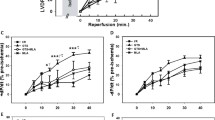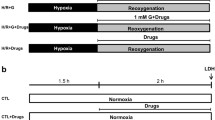Abstract
Acetylcholine (ACh) has been shown to exert cardioprotection against myocardial ischemia/reperfusion (I/R) injury. However, whether ACh exerts its cardioprotection predominantly through the activation of muscarinic or nicotinic ACh receptors is not fully understood. We investigated the effects of hypoxia/reoxygenation (H/R) in the presence or absence of ACh receptor agonists in H9c2 cells. Cells (2.5 × 105 cells/well) were incubated in the hypoxic chamber with the ischemic solution (30 min) followed by reoxygenation (120 min) with the normal media. ACh or nicotinic ACh receptor agonist (GTS21) was applied 5 min prior to hypoxia, during hypoxia or at reoxygenation onset. Cell viability, apoptosis, ER stress, mitochondrial dynamics and biogenesis were determined. H/R significantly decreased cell viability and mitochondrial biogenesis and increased apoptosis, ER stress, mitochondrial fission and autophagic flux compared with the control. ACh and GTS21 significantly increased cell viability via reducing apoptosis, autophagy, and ER stress. However, ACh and GTS21 increased mitochondrial fusion when applied before or during hypoxia. During reoxygenation onset, only ACh increased mitochondrial biogenesis. Co-treatment with atropine reversed the beneficial effects of ACh and GTS21. Our findings demonstrated that ACh exerted cytoprotection against H/R-induced apoptosis, autophagy and mitochondrial impairment through the activation of both muscarinic and nicotinic receptors.







Similar content being viewed by others
Data availability
All data supporting the findings of this study are available from the corresponding author upon reasonable request.
References
Hausenloy DJ, Yellon DM (2013) Myocardial ischemia-reperfusion injury: a neglected therapeutic target. J Clin Invest 123:92–100
Yellon DM, Hausenloy DJ (2007) Myocardial reperfusion injury. N Engl J Med 357:1121–1135
Turer AT, Hill JA (2010) Pathogenesis of myocardial ischemia-reperfusion injury and rationale for therapy. Am J Cardiol 106:360–368
Ong S-B, Gustafsson ÅB (2011) New roles for mitochondria in cell death in the reperfused myocardium. Cardiovasc Res 94:190–196
Lesnefsky EJ, Chen Q, Tandler B, Hoppel CL (2017) Mitochondrial dysfunction and myocardial ischemia-reperfusion: implications for novel therapies. Annu Rev Pharmacol Toxicol 57:535–565
Zhou H, Toan S (2020) Pathological roles of mitochondrial oxidative stress and mitochondrial dynamics in cardiac microvascular ischemia/reperfusion injury. Biomolecules 10:85
Zhou H, Wang J, Hu S, Zhu H, Toanc S, Ren J (2019) BI1 alleviates cardiac microvascular ischemia-reperfusion injury via modifying mitochondrial fission and inhibiting XO/ROS/F-actin pathways. J Cell Physiol 234:5056–5069
Kubli DA, Gustafsson ÅB (2012) Mitochondria and mitophagy: the yin and yang of cell death control. Circ Res 111:1208–1221
Ashrafi G, Schwarz TL (2013) The pathways of mitophagy for quality control and clearance of mitochondria. Cell Death Differ 20:31–42
Maneechote C, Palee S, Kerdphoo S, Jaiwongkam T, Chattipakorn SC, Chattipakorn N (2019) Balancing mitochondrial dynamics via increasing mitochondrial fusion attenuates infarct size and left ventricular dysfunction in rats with cardiac ischemia/reperfusion injury. Clin Sci (Lond) 133:497–513
Sun L, Zhao M, Yang Y et al (2016) Acetylcholine attenuates hypoxia/reoxygenation injury by inducing mitophagy through PINK1/Parkin signal pathway in H9c2 cells. J Cellr Physiol 231:1171–1181
Sun L, Zang WJ, Wang H et al (2014) Acetylcholine promotes ROS detoxification against hypoxia/reoxygenation-induced oxidative stress through FoxO3a/PGC-1α dependent superoxide dismutase. Cell Physiol Biochem 34:1614–1625
Zhao M, Sun L, Yu XJ et al (2013) Acetylcholine mediates AMPK-dependent autophagic cytoprotection in H9c2 cells during hypoxia/reoxygenation injury. Cell Physiol Biochem 32:601–613
Miao Y, Zhou J, Zhao M et al (2013) Acetylcholine attenuates hypoxia/reoxygenation-induced mitochondrial and cytosolic ROS formation in H9c2 cells via M2 acetylcholine receptor. Cell Physiol Biochem 31:189–198
Kimes BW, Brandt BL (1976) Properties of a clonal muscle cell line from rat heart. Exp Cell Res 98:367–381
Hescheler J, Meyer R, Plant S, Krautwurst D, Rosenthal W, Schultz G (1991) Morphological, biochemical, and electrophysiological characterization of a clonal cell (H9c2) line from rat heart. Circ Res 69:1476–1486
Watkins SJ, Borthwick GM, Arthur HM (2011) The H9C2 cell line and primary neonatal cardiomyocyte cells show similar hypertrophic responses in vitro. In Vitro Cell Dev Biol Anim 47:125–131
Chanoit G, Lee S, Xi J et al (2008) Exogenous zinc protects cardiac cells from reperfusion injury by targeting mitochondrial permeability transition pore through inactivation of glycogen synthase kinase-3β. Am J Physiol Heart Circ Physiol 295:H1227–H1233
Mavropoulos SA, Khan NS, Levy ACJ et al (2017) Nicotinic acetylcholine receptor-mediated protection of the rat heart exposed to ischemia reperfusion. Mol Med 23:120–133
Zhao M, Yang Y, Bi X et al (2015) Acetylcholine attenuated TNF-α-induced apoptosis in H9c2 cells: role of calpain and the p38-MAPK pathway. Cell Physiol Biochem 36:1877–1889
Thorburn A (2008) Apoptosis and autophagy: regulatory connections between two supposedly different processes. Apoptosis 13:1–9
Krijnen PA, Nijmeijer R, Meijer CJ, Visser CA, Hack CE, Niessen HW (2002) Apoptosis in myocardial ischaemia and infarction. J Clin Pathol 55:801–811
Eefting F, Rensing B, Wigman J et al (2004) Role of apoptosis in reperfusion injury. Cardiovasc Res 61:414–426
Stefan WR, Suzanne MC, Augustine MKC (2013) Autophagy: a critical regulator of cellular metabolism and homeostasis. Mol Cells 36:7–16
Ma S, Wang Y, Chen Y, Cao F (2015) The role of the autophagy in myocardial ischemia/reperfusion injury. Biochim Biophys Acta 1852:271–276
Denton D, Kumar S (2019) Autophagy-dependent cell death. Cell Death Differ 26:605–616
Elmore S (2007) Apoptosis: a review of programmed cell death. Toxicol Pathol 35:495–516
Yue R, Hu H, Yiu KH et al (2012) Lycopene protects against hypoxia/reoxygenation-induced apoptosis by preventing mitochondrial dysfunction in primary neonatal mouse cardiomyocytes. PLoS ONE 7:e50778
Ong SB, Dongworth RK, Cabrera-Fuentes HA, Hausenloy DJ (2015) Role of the MPTP in conditioning the heart—translatability and mechanism. Br J Pharmacol 172:2074–2084
Giacomello M, Pyakurel A, Glytsou C, Scorrano L (2020) The cell biology of mitochondrial membrane dynamics. Nat Rev Mol Cell Biol 21:204–224
Chandel NS (2014) Mitochondria as signaling organelles. BMC Biol 12:34
Peoples JN, Saraf A, Ghazal N, Pham TT, Kwong JQ (2019) Mitochondrial dysfunction and oxidative stress in heart disease. Exp Mol Med 51:1–13
Walters JW, Amos D, Ray K, Santanam N (2016) Mitochondrial redox status as a target for cardiovascular disease. Curr Opin Pharmacol 27:50–55
Saito T, Sadoshima J (2015) Molecular mechanisms of mitochondrial autophagy/mitophagy in the heart. Circ Res 116:1477–1490
Archer SL (2013) Mitochondrial dynamics–mitochondrial fission and fusion in human diseases. N Engl J Med 369:2236–2251
Dong Y, Undyala VVR, Przyklenk K (2016) Inhibition of mitochondrial fission as a molecular target for cardioprotection: critical importance of the timing of treatment. Basic Res Cardiol 111:59
Nuntaphum W, Pongkan W, Wongjaikam S et al (2018) Vagus nerve stimulation exerts cardioprotection against myocardial ischemia/reperfusion injury predominantly through its efferent vagal fibers. Basic Res Cardiol 113:22
Shinlapawittayatorn K, Chinda K, Palee S et al (2014) Vagus nerve stimulation initiated late during ischemia, but not reperfusion, exerts cardioprotection via amelioration of cardiac mitochondrial dysfunction. Heart Rhythm 11:2278–2287
Shinlapawittayatorn K, Chinda K, Palee S et al (2013) Low-amplitude, left vagus nerve stimulation significantly attenuates ventricular dysfunction and infarct size through prevention of mitochondrial dysfunction during acute ischemia-reperfusion injury. Heart Rhythm 10:1700–1707
Intachai K, Chattipakorn SC, Chattipakorn N, Shinlapawittayatorn K (2018) Revisiting the cardioprotective effects of acetylcholine receptor activation against myocardial ischemia/reperfusion injury. Int J Mol Sci 19:2466
Sun L, Zhao M, Yu XJ et al (2013) Cardioprotection by acetylcholine: a novel mechanism via mitochondrial biogenesis and function involving the PGC-1α pathway. J Cell Physiol 228:1238–1248
Hou Z, Zhou Y, Yang H et al (2018) Alpha7 nicotinic acetylcholine receptor activation protects against myocardial reperfusion injury through modulation of autophagy. Biochem Biophys Res Commun 500:357–364
Hu C, Tian Y, Xu H et al (2018) Inadequate ubiquitination-proteasome coupling contributes to myocardial ischemia-reperfusion injury. J Clin Invest 128:5294–5306
Patel HH, Murray F, Insel PA (2008) Caveolae as organizers of pharmacologically relevant signal transduction molecules. Annu Rev Pharmacol Toxicol 48:359–391
Harvey RD, Calaghan SC (2012) Caveolae create local signalling domains through their distinct protein content, lipid profile and morphology. J Mol Cell Cardiol 52:366–375
Insel PA, Head BP, Ostrom RS et al (2005) Caveolae and lipid rafts: G protein-coupled receptor signaling microdomains in cardiac myocytes. Ann N Y Acad Sci 1047:166–172
Balijepalli RC, Kamp TJ (2008) Caveolae, ion channels and cardiac arrhythmias. Prog Biophys Mol Biol 98:149–160
Li P, Yan Y, Shi Y et al (2019) Nicotinic agonist inhibits cardiomyocyte apoptosis in CVB3-Induced myocarditis via α3β4-nAChR/PI3K/Akt-dependent survivin upregulation. Oxid Med Cell Longev 2019:9496419–9496419
Liu Y, Wang S, Wang C et al (2013) Upregulation of M3 muscarinic receptor inhibits cardiac hypertrophy induced by angiotensin II. J Transl Med 11:209
Palee S, Apaijai N, Shinlapawittayatorn K, Chattipakorn SC, Chattipakorn N (2016) Acetylcholine attenuates hydrogen peroxide-induced intracellular calcium dyshomeostasis through both muscarinic and nicotinic receptors in cardiomyocytes. Cell Physiol Biochem 39:341–349
Acknowledgements
This study was supported by the Thailand Research Fund Royal Golden Jubilee PhD program PHD/0103/2561 (KI and KS), the National Research Council of Thailand Grant No. 2563NRCT321511 (KS), Senior Research Scholar grant from the National Research Council of Thailand (SCC), Thailand Science Research and Innovation-Fundamental Fund-Chiang Mai University (KS), a NSTDA Research Chair Grant from the National Science and Technology Development Agency Thailand (NC), Chiang Mai University Endowment Fund (KS) and the Chiang Mai University Center of Excellence Award (NC).
Author information
Authors and Affiliations
Contributions
KS, SCC, NC—Conceptualization, KI—Collecting Data, KI, K.S—Analyzing Data, KI, KS—Writing—Original Draft Preparation, KS, SCC, NC—Writing—Review & Editing.
Corresponding author
Ethics declarations
Conflict of interest
The authors declare that there are no conflicts of interest.
Additional information
Publisher's Note
Springer Nature remains neutral with regard to jurisdictional claims in published maps and institutional affiliations.
Rights and permissions
About this article
Cite this article
Intachai, K., Chattipakorn, S.C., Chattipakorn, N. et al. Acetylcholine exerts cytoprotection against hypoxia/reoxygenation-induced apoptosis, autophagy and mitochondrial impairment through both muscarinic and nicotinic receptors. Apoptosis 27, 233–245 (2022). https://doi.org/10.1007/s10495-022-01715-2
Accepted:
Published:
Issue Date:
DOI: https://doi.org/10.1007/s10495-022-01715-2




